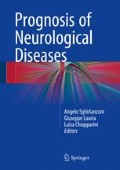Abstract
Toxic and deficiency encephalopathies (TDE) (e.g., hepatic and uremic encephalopathies) are usually reversible events. Risk factors for incomplete recovery are duration of encephalopathy and its severity, advanced age, and preexisting neurodegenerative disease.
Wernicke’s encephalopathy is progressive and leads to coma and death if untreated. The mortality is 10–20 %, even with appropriate treatment.
Korsakoff’s syndrome and Marchiafava-Bignami disease sufferers rarely recover despite apparently appropriate treatment.
For vitamin B 12 deficiency, at least partial improvement can be obtained with adequate treatment.
Access this chapter
Tax calculation will be finalised at checkout
Purchases are for personal use only
References
Lockwood AH. Toxic and metabolic encephalopathies. In: Bradley WG, Daroff RB, Fenichel GM, Jankovic J, editors. Neurology in clinical practice. Philadelphia: Butterworth Einemann; 2004. p. 1673–92.
Plum F, Posner JB. The diagnosis of Stupor and Coma. Philadelphia: FA Davis Company; 1982.
Earnest MP, Parker D. Metabolic encephalopathies and coma from medical causes. In: Grotta J, editor. Management of the acutely ill neurological patient. New York: Churchill Livingstone; 1993. p. 1–15.
Oddo M, Carrera E, Claassen J, et al. Continuous electroencephalography in the medical intensive care unit. Crit Care Med. 2009;37:2051–6.
Krishnan V, Leung LY, Caplan LR. A neurologist’s approach to delirium: diagnosis and management of toxic metabolic encephalopathies. Eur J Intern Med. 2013. doi:10.1016/j.ejim.2013.11.010.
Levy DE, Bates D, Caronna JJ, et al. Prognosis in non traumatic coma. Ann Intern Med. 1981;94(3):293–301.
Jørgensen EO, Malchow-Møller A. Natural hystory of global and critical brain ischaemia. Part I: neurological signs during the first year after cardiopulmonary resuscitation in patients subsequently regaining consciousness. Resuscitation. 1981;9(2):133–53.
Bates D. The prognosis of medical coma. J Neurol Neurosurg Psychiatry. 2001;71 Suppl 1:20–3.
Jackson JC, Hart RP, Gordon SM, et al. Six-month neuropsychological outcome of medical intensive care unit patients. Crit Care Med. 2003;31:1226–34.
Gordon SM, Jackson JC, Ely EW, et al. Clinical identification of cognitive impairment in ICU survivors: insights for intensivists. Intensive Care Med. 2004;30(11):1997–2008.
Ferenci P, Lockwood A, Mullen K, et al. Hepatic encephalopathy–definition, nomenclature, diagnosis, and quantification: final report of the working party at the 11thWorld Congresses of Gastroenterology, Vienna, 1998. Hepatology. 2002;35:716–21.
Sutter R, Kaplan PW. Neuroimaging correlates of acute encephalopathy. J Clin Neurophysiol. 2013;30(5):517–25.
Weissenborn K, Ennen JC, Schomerus H, et al. Neuropsychological characterization of hepatic encephalopathy. J Hepatol. 2001;34:768–77.
Garcia-Tsao G, Lim JK, et al. Management and treatment of patients with cirrhosis and portal hypertension: recommendations from the Department of Veterans Affairs Hepatitis C Resource Center Program and the National Hepatitis C Program. Am J Gastroenterol. 2009;104:1802–29.
Bajaj JS. Review article: the modern management of hepatic encephalopathy. Aliment Pharmacol Ther. 2010;31:537–47.
Bajaj JS, Schubert CM, Heuman DM, et al. Persistence of cognitive impairment after resolution of overt hepatic encephalopathy. Gastroenterology. 2010;138(7):2332–40.
Brouns R, De Deyn PP. Neurological complications in renal failure: a review. Clin Neurol Neurosurg. 2004;107:1–16.
Victor M, Adams RA, Collins GH. The Wernicke-Korsakoff syndrome and related disorders due to alcoholism and malnutrition. Philadelphia: FA Davis; 1989.
Harper CG, Giles M, Finlay-Jones R. Clinical signs in the Wernicke-Korsakoff complex: a retrospective analysis of 131 cases diagnosed at necropsy. J Neurol Neurosurg Psychiatry. 1986;49(4):341–5.
Agabio R. Thiamine administration in alcohol-dependent patients. Alcohol Alcohol. 2005;40(2):155–6.
Phillips BK, Ingram MV, Grammer GG. Wernicke-Korsakoff syndrome and galantamine. Psychosomatics. 2004;45(4):366–8.
Rustembegović A, Kundurović Z, Sapcanin A, et al. A placebo-controlled study of memantine (Ebixa) in dementia of Wernicke-Korsakoff syndrome. Med Arh. 2003;57(3):149–50.
Hillbom M, Saloheimo P, Fujioka S, et al. Diagnosis and management of marchiafava-Bignami disease: a review of CT/MRI confirmed cases. J Neurol Neurosurg Psychiatry. 2013. doi:10.1136/jnnp-2013-305979.
Harper CG, Kril JJ. Corpus callosal thickness in alcoholics. Br J Addict. 1988;83(5):577–80.
Kumar N. Acute and subacute encephalopathies: deficiency states (nutritional). Semin Neurol. 2011;31(2):169–83.
Vasconcelos OM, Poehm EH, McCarter RJ, Campbell WW, Quezado ZM. Potential outcome factors in subacute combined degeneration: review of obsrevational studies. J Gen Intern Med. 2006;21(10):1063–8.
Author information
Authors and Affiliations
Corresponding author
Editor information
Editors and Affiliations
Rights and permissions
Copyright information
© 2015 Springer-Verlag Italia
About this chapter
Cite this chapter
Rigamonti, A., Agostoni, E. (2015). Toxic and Deficiency Encephalopathies. In: Sghirlanzoni, A., Lauria, G., Chiapparini, L. (eds) Prognosis of Neurological Diseases. Springer, Milano. https://doi.org/10.1007/978-88-470-5755-5_18
Download citation
DOI: https://doi.org/10.1007/978-88-470-5755-5_18
Publisher Name: Springer, Milano
Print ISBN: 978-88-470-5754-8
Online ISBN: 978-88-470-5755-5
eBook Packages: MedicineMedicine (R0)

